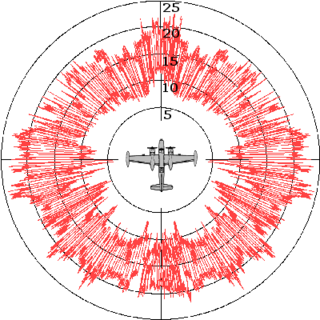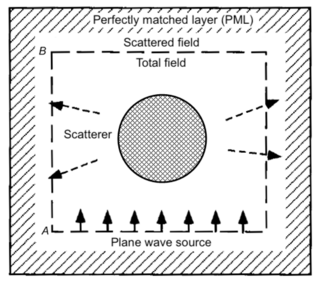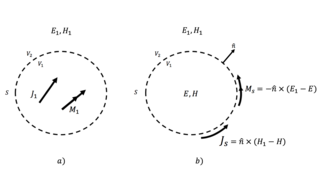Related Research Articles

Radar cross-section (RCS), denoted σ, also called radar signature, is a measure of how detectable an object is by radar. A larger RCS indicates that an object is more easily detected.
The boundary element method (BEM) is a numerical computational method of solving linear partial differential equations which have been formulated as integral equations, including fluid mechanics, acoustics, electromagnetics, fracture mechanics, and contact mechanics.

Finite-difference time-domain (FDTD) or Yee's method is a numerical analysis technique used for modeling computational electrodynamics. Since it is a time-domain method, FDTD solutions can cover a wide frequency range with a single simulation run, and treat nonlinear material properties in a natural way.

Computational electromagnetics (CEM), computational electrodynamics or electromagnetic modeling is the process of modeling the interaction of electromagnetic fields with physical objects and the environment using computers.

A perfectly matched layer (PML) is an artificial absorbing layer for wave equations, commonly used to truncate computational regions in numerical methods to simulate problems with open boundaries, especially in the FDTD and FE methods. The key property of a PML that distinguishes it from an ordinary absorbing material is that it is designed so that waves incident upon the PML from a non-PML medium do not reflect at the interface—this property allows the PML to strongly absorb outgoing waves from the interior of a computational region without reflecting them back into the interior.
Electromagnetic field solvers are specialized programs that solve Maxwell's equations directly. They form a part of the field of electronic design automation, or EDA, and are commonly used in the design of integrated circuits and printed circuit boards. They are used when a solution from first principles or the highest accuracy is required.

Allen Taflove was a full professor in the Department of Electrical and Computer Engineering of Northwestern's McCormick School of Engineering, since 1988. Since 1972, he pioneered basic theoretical approaches, numerical algorithms, and applications of finite-difference time-domain (FDTD) computational solutions of Maxwell's equations. He coined the descriptors "finite difference time domain" and "FDTD" in the 1980 paper, "Application of the finite-difference time-domain method to sinusoidal steady-state electromagnetic penetration problems." In 1990, he was the first person to be named a Fellow of the Institute of Electrical and Electronics Engineers (IEEE) in the FDTD area. Taflove was the recipient of the 2014 IEEE Electromagnetics Award with the following citation: "For contributions to the development and application of finite-difference time-domain (FDTD) solutions of Maxwell's equations across the electromagnetic spectrum." He was a Life Fellow of the IEEE and a Fellow of the Optical Society (OSA). His OSA Fellow citation reads: "For creating the finite-difference time-domain method for the numerical solution of Maxwell's equations, with crucial application to the growth and current state of the field of photonics."
The finite-difference frequency-domain (FDFD) method is a numerical solution method for problems usually in electromagnetism and sometimes in acoustics, based on finite-difference approximations of the derivative operators in the differential equation being solved.
Eigenmode expansion (EME) is a computational electrodynamics modelling technique. It is also referred to as the mode matching technique or the bidirectional eigenmode propagation method. Eigenmode expansion is a linear frequency-domain method.
Dr. Raymond J. Luebbers was Professor of Electrical Engineering at The Pennsylvania State University and Ohio University, a Research Scientist at the Lockheed Martin Research Laboratory in Palo Alto, CA and founder of Remcom, Inc.
Raj Mittra is an Indian-born electrical engineer and academician. He is currently a professor of electrical engineering at University of Central Florida. Previously, he was a faculty member at University of Illinois at Urbana–Champaign and Pennsylvania State University, where he was the director of the Electromagnetic Communication Laboratory of the Electrical Engineering department. His specialities include computational electromagnetics and communication antenna design.

Annalisa Buffa is an Italian mathematician, specializing in numerical analysis and partial differential equations (PDE). She is a professor of mathematics at EPFL and holds the Chair of Numerical Modeling and Simulation.
Stephen D. Gedney is an American electrical engineer, currently a Distinguished Professor of Electrical Engineering at the University of Colorado Denver's College of Engineering, Design and Computing. Gedney is a pioneer in computational electromagnetic techniques. He is most widely known for his development of the Uniaxial Perfectly Matched Layer media method, the complex-frequency shifted convolutional PML, along with J. Alan Roden, and his contributions to the Locally Corrected Nystrom method. Gedney's papers and textbook on the finite difference time domain technique in particular are widely cited. Gedney is an IEEE Fellow.
Ulrich Jakobus is Senior Vice President - Electromagnetic Solutions of Altair, Germany and was awarded Fellow of the Institute of Electrical and Electronics Engineers (IEEE) in 2013 for leadership in hybrid computational tool development and commercialization. His research laid the foundations for the commercial electromagnetics code FEKO which is used in antenna design, antenna placement, electromagnetic compatibility, microwave components, bioelectromagnetics, radar cross section and related fields.

Weng Cho Chew is a Malaysian-American electrical engineer and applied physicist known for contributions to wave physics, especially computational electromagnetics. He is a Distinguished Professor of Electrical and Computer Engineering at Purdue University.
Roger Fuller Harrington is an American electrical engineer and professor emeritus at Syracuse University. He is best known for his contributions to computational electromagnetics with his development of method of moments (MoM). Harrington's 1968 book, Field Computation by Moment Methods, is regarded as a pivotal textbook on the subject.

In electromagnetism, surface equivalence principle or surface equivalence theorem relates an arbitrary current distribution within an imaginary closed surface with an equivalent source on the surface. It is also known as field equivalence principle, Huygens' equivalence principle or simply as the equivalence principle. Being a more rigorous reformulation of the Huygens–Fresnel principle, it is often used to simplify the analysis of radiating structures such as antennas.
Tapan Kumar Sarkar was an Indian-American electrical engineer and Professor Emeritus at the Department of Electrical Engineering and Computer Science at Syracuse University. He was best known for his contributions to computational electromagnetics and antenna theory.

The method of moments (MoM), also known as the moment method and method of weighted residuals, is a numerical method in computational electromagnetics. It is used in computer programs that simulate the interaction of electromagnetic fields such as radio waves with matter, for example antenna simulation programs like NEC that calculate the radiation pattern of an antenna. Generally being a frequency-domain method, it involves the projection of an integral equation into a system of linear equations by the application of appropriate boundary conditions. This is done by using discrete meshes as in finite difference and finite element methods, often for the surface. The solutions are represented with the linear combination of pre-defined basis functions; generally, the coefficients of these basis functions are the sought unknowns. Green's functions and Galerkin method play a central role in the method of moments.
Melinda Jane Piket-May is an American engineer who is a professor of engineering at the University of Colorado Boulder. Her research investigates numerical modeling of electromagnetic phenomena and new strategies for more inclusive engineering education.
References
- ↑ Yee, Kane Shee-Gong (1958). Analysis of a cylindrical cavity resonator with finite wall thickness (MS). University of California, Berkeley.
- 1 2 Pile, David (23 December 2014). "Numerical solution: Interview with Allen Taflove". Nature Photonics . 9: 5–6. doi:10.1038/nphoton.2014.305. S2CID 56374370.
- 1 2 3 Yee, Kane S. (February 1974). "A Closed-Form Expression for the Energy Dissipation in a Low-Loss Transmission Line". IEEE Transactions on Nuclear Science . 21 (1): 1006–1008. Bibcode:1974ITNS...21.1006Y. doi:10.1109/TNS.1974.4327594.
- 1 2 Yee, Kane S.; Chen, Jei S. (March 1997). "The finite-difference time-domain (FDTD) and the finite-volume time-domain (FVTD) methods in solving Maxwell's equations". IEEE Transactions on Antennas and Propagation . 45 (3): 354–363. Bibcode:1997ITAP...45..354Y. doi:10.1109/8.558651.
- ↑ Yee, Kane (March 1963). Boundary-value problems for Maxwell's equations (PhD). University of California, Berkeley.
- ↑ Yee, Kane S. (May 1966). "Numerical Solution of Initial Boundary Value Problems Involving Maxwell's Equations in Isotropic Media" (PDF). IEEE Transactions on Antennas and Propagation . 14 (3): 302–307. Bibcode:1966ITAP...14..302Y. doi:10.1109/TAP.1966.1138693. S2CID 122712881.
- ↑ Lam, Dong-Hoa (1969). "Finite Difference Methods for Electromagnetic Scattering Problems". Mississippi State University, Interaction Notes. 44.
- ↑ Taflove, A.; Brodwin, M. E. (1975). "Numerical solution of steady-state electromagnetic scattering problems using the time-dependent Maxwell's equations" (PDF). IEEE Transactions on Microwave Theory and Techniques. 23 (8): 623–630. Bibcode:1975ITMTT..23..623T. doi:10.1109/TMTT.1975.1128640.
- ↑ Taflove, A. (1980). "Application of the finite-difference time-domain method to sinusoidal steady state electromagnetic penetration problems" (PDF). IEEE Trans. Electromagn. Compat. 22 (3): 191–202. Bibcode:1980ITElC..22..191T. doi:10.1109/TEMC.1980.303879. S2CID 39236486.
- ↑ Taflove, Allen; Hagness, Susan (2000). Computational Electrodynamics: The Finite-Difference Time-Domain Method (2 ed.). Norwood, MA: Artech House. pp. 75–79. ISBN 1580530761.
- ↑ Inan, Umran; Marshall, Robert A. (2011). Numerical Electromagnetics: The FDTD Method (2 ed.). New York, NY: Cambridge University Press. pp. 72–74. ISBN 978-1139497985.